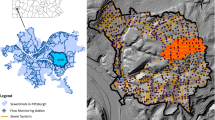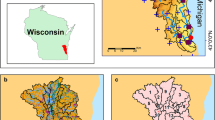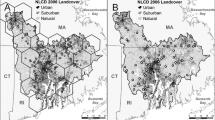Abstract
Urbanisation causes a range of adverse impacts on stream physical and ecological conditions due to increases in catchment runoff caused by increased imperviousness. Developing ways to reduce these impacts on in-stream ecosystems is a major challenge and requires innovative catchment specific, high-time-resolution modelling methods. We employed a combination of high-time-resolution data collection, analysis and modelling methods to understand the underlying hydrological processes and evaluate a potentially significant management option – stormwater harvesting. A set of sensitive parameters of the Storm Water Management Model (SWMM) were optimised using an automatic calibration method and hourly data in eight catchments in South East Queensland, Australia. Systematic investigation of the effects of urbanisation and its mitigation through stormwater harvesting was achieved by modelling the impacts of increasing impervious area for three of the relatively undeveloped catchments. As the extent of impervious areas across the catchments increased we typically found increases in the duration of high flow spells together with increases in mean flow and the frequency of runoff events. However, many hydrologic responses to increasing imperviousness were specific to the physical characteristics of catchments, and to the spatio-temporal pattern of urbanisation. By implementing stormwater harvesting options the hourly flows were reduced by up to 60 % but the maximum flow was unchanged. Thus the option was able to reduce, but not totally ameliorate, the negative hydrological impacts of increasing imperviousness.





Similar content being viewed by others
References
Ashbolt S et al. (2012) Can stormwater harvesting restore pre-development flows in urban catchments in south East Queensland? Water Sci Technol 67:446–451
Brodie I (2012) Stormwater harvesting and WSUD frequent flow management: a compatibility analysis. Water Sci Technol 66:612–619
Bunn SE, Arthington AH (2002) Basic principles and ecological consequences of altered flow regimes for aquatic biodiversity. Environ Manag 30:492–507
Bureau of Meteorology (2012) Average annual and monthly evapotranspiration. http://www.bom.gov.au/jsp/ncc/climate_averages/evapotranspiration/index.jsp?maptype=3&period=an#maps. Accessed 20 November 2012.
Calver A, Lamb R (1995) Flood frequency estimation using continuous rainfall runoff modelling. Phys. Chem. Earth 20(5–6):479–483
Choi K, Ball JE (2002) Parameter estimation for urban runoff modelling. Urban Water 4:31–141
Chowdhury R et al. (2012) SEQ Catchment modelling for stormwater harvesting research: instrumentation and hydrological model calibration and validation. Brisbane: Urban Water Security Research Alliance Technical Report, No. 83. http://www.urbanwateralliance.org.au/publications/UWSRA-tr83.pdf
Delleur JW (2003) The evolution of urban hydrology: past, present, and future. J Hydraul Eng 129:563–573
Dietz ME, Clausen JC (2008) Stormwater runoff and export changes with development in a traditional and low impact subdivision. J Environ Manag 87:560–566
Duan Q, Sorooshian S, Gupta V (1992) Effective and efficient global optimization for conceptual rainfall-runoff models. Water Resour Res 28:1015–1031
Fletcher TD, Andrieu H, Hamel P (2013) Understanding, management and modelling of urban hydrology and its consequences for receiving waters: a state of the art. Adv Water Resour 51:261–279
Gassman PW et al. (2007) The soil and water assessment tool: historical development, applications, and future research directions. Trans ASABE 50:1211–1250
Goff KM, Gentry RW (2006) The influence of watershed and development characteristics on the cumulative impacts of Stormwater detention ponds. Water Resour Manag 20:829–860
Gwenzi W, Nyamadzawo G (2014) Hydrological impacts of urbanization and urban roof water harvesting in water-limited Catchments: A review. Environ Prog 1:573–593
Jacobson CR (2011) Identification and quantification of the hydrological impacts of imperviousness in urban catchments: a review. J Environ Manag 92:1438–1448
Jang S et al. (2007) Using SWMM as a tool for hydrologic impact assessment. Desalination 212:344–356
Javaheri H (1998) Automatic calibration of urban runoff models using global optimization techniques. Thesis (M. Eng). Department of Civil Engineering and Applied Mechanics, McGill University.
Kennard MJ et al. (2010) Classification of natural flow regimes in Australia to support environmental flow management. Freshw Biol 55:171–193
Lamb R (1999) Calibration of a conceptual rainfall-runoff model for flood frequency estimation by continuous simulation. Water Resour Res 35:3103–3114
Nash JE, Sutcliffe JV (1970) River flow forecasting through conceptual models, 1: a discussion of principles. J Hydrol 10:282–290
Paul MJ, Meyer JL (2001) Streams in the urban landscape. Annu Rev Ecol Syst 32:333–365
Pilgrim DH, Cordery I (1993) Flood runoff. In: Maidment DR (ed) Handbook of Hydrology. McGraw-Hill Inc.
Refsgaard JC, Storm B, Refsgaard A (1995) Validation and applicability of distributed hydrological models, Modelling and Management of Sustainable Basin-scale Water Resource Systems. In: Proceedings of a Boulder Symposium,: IAHS, Publ no 231, 387–397.
Rolls RJ, Leigh C, Sheldon F (2012) Mechanistic effects of low-flow hydrology on riverine ecosystems: ecological principles and consequences of alteration. Freshwater. Science 31(4):1163–1186
Rose S, Peters NE (2001) Effects of urbanization on streamflow in the Atlanta area (Georgia, USA): a comparative hydrological approach. Hydrol Process 15:1441–1457
Shuster WD et al. (2005) Impacts of impervious surface on watershed hydrology: a review. Urban Water J 2:263–275
Simpson MG (2010) Low impact development modeling to manage urban stormwater runoff and restore predevelopment site hydrology. Unpublished master’s thesis. Colorado State University, Fort Collins https://dspace.library.colostate.edu/handle/10217/39121, Accessed 08 July 2016
Tsihrintzis VA, Hamid R (1998) Runoff quality prediction from small urban catchments using SWMM. Hydrol Process 12:311–329
UN HABITAT (2012) State of the World’s Cities 2010/2011 – Cities for All: Bridging the Urban Divide. Earthscan Publishers, London
USEPA (2016) Storm water management model (SWMM). https://www.epa.gov/water-research/storm-water-management-model-swmm, Accessed 8 July 2016.
USGS (2012) The effects of urbanization on water quality, The USGS Water Science School http://ga.water.usgs.gov/edu/urbanquality.html. Accessed 17 October 2012.
Vaze J, Chiew FHS (2003) Study of pollutant washoff from small impervious experimental plots. Water Resour Res 39:1160
Walsh CJ, Fletcher TD, Ladson AR (2005) Stream restoration in urban catchments through redesigning stormwater systems: looking to the catchment to save the stream. J North American Benthological Soc 24:690–705
Water by Design (2009) Draft Stormwater Harvesting Guidelines, South East Queensland Healthy Waterways Partnership. http://waterbydesign.com.au/stormwaterharvesting-2/. Accessed 04 July 2014.
Zaghloul NA (1983) Sensitivity analysis of the SWMM runoff-transport parameters and the effects of catchment discretisation. Adv Water Resour 6:214–223
Zhang S, Guo Y (2013) Stormwater capture efficiency of bioretention systems. Water Resour Manag 28:149–168
Acknowledgments
The study was funded by the Urban Water Security Research Alliance (www.urbanwateralliance.org.au). We thank Queensland Department of Science, Innovation, Technology and Innovation for supplying the streamflow and rainfall data. Thanks also to Justin Hughes and Jai Vaze for their thoughtful comments on an earlier draft.
Author information
Authors and Affiliations
Corresponding author
Additional information
Highlights
• Scenarios of runoff capture from urbanised areas do not fully ameliorate impacts of urbanisation.
• Effectiveness of runoff capture at reducing high flows decreases with increasing imperviousness.
• Effects of increasing imperviousness on flow is harder to interpret in larger catchments.
• Duration of high flow conditions and frequency of runoff increases with the extent of imperviousness.
• Changes in flows depend on catchment characteristics, and pattern and intensity of urbanisation.
Rights and permissions
About this article
Cite this article
Aryal, S.K., Ashbolt, S., McIntosh, B.S. et al. Assessing and Mitigating the Hydrological Impacts of Urbanisation in Semi-Urban Catchments Using the Storm Water Management Model. Water Resour Manage 30, 5437–5454 (2016). https://doi.org/10.1007/s11269-016-1499-z
Received:
Accepted:
Published:
Issue Date:
DOI: https://doi.org/10.1007/s11269-016-1499-z




